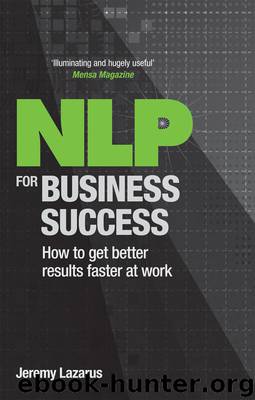NLP for Business Success by Jeremy Lazarus

Author:Jeremy Lazarus
Language: eng
Format: epub
Publisher: Crimson Publishing Ltd
An overview of anchoring
An anchor is defined in NLP as ‘a stimulus that leads to a response in other people or yourself’. One of the earliest and best-known exponents of anchoring was the Russian physiologist, Ivan Pavlov, whose famous experiment with dogs in 1904 showed how they could be trained to respond to certain preset stimuli. Anchoring could be regarded as an entirely natural human response and anchors can be set using any or all of the representational systems. You automatically respond (positively or negatively) to a variety of events, such as:
• the sound of your favourite upbeat music or, at work, the voice of your boss or most important customer
• the sight of your best friend’s face or, at work, seeing the managing director walk into the building
• the smell of freshly ground coffee or, at work, the perfume/aftershave of your boss
• the feel of your favourite freshly ironed shirt or blouse as you get dressed for an important interview
• the taste of apple pie like your grandmother used to make.
One of the principles of anchoring is that you can create your own stimulus–response mechanisms for yourself, and even create or evoke states in other people. Diagram 10.1 shows this.
If you remember a time when you felt, for example, really excited and relive that specific event, your state will intensify, reach a peak (typically for 5–15 seconds) and then you will return to your everyday base-line state (shown by the inverted U in Diagram 10.1). If you link the peak of the state (shown by the think line) to a specific movement, such as squeezing your thumb and index finger together, and repeat this process a few times, the state (‘excitement’ in this case) and the movement will become neurologically linked, so that if you repeat the thumb–finger movement before or during a business meeting you will feel in the state you have anchored (i.e. excited).
Download
This site does not store any files on its server. We only index and link to content provided by other sites. Please contact the content providers to delete copyright contents if any and email us, we'll remove relevant links or contents immediately.
Neuro-linguistic Programming for Dummies by Romilla Ready & Kate Burton(1562)
Free Yourself from Fears by Joseph O'Connor(1540)
Foolproof Persuasion: The Visual Guide To Influencing Others Without Ever Being Wrong by Vinh Ly(1467)
Moneyball by Michael Lewis(1397)
Beliefs by Robert Dilts(1392)
Moneyball: The Art of Winning an Unfair Game by Michael Lewis(1273)
NLP by Tom Hoobyar(1246)
NLP For Parents by Judy Bartkowiak(1221)
Forward: A Memoir by Abby Wambach(1196)
Get Laid or Die Trying by Jeff Allen(1174)
Mind Control Hypnosis by Dantalion Jones(1164)
Dark NLP: How To Use Neuro-linguistic Programming For Self Mastery, Getting What You Want, Mastering Others And To Gain An Advantage Over Anyone by Pace Michael(1163)
Neurolinguistic Programming (NLP) by Neil Shah(1125)
Breaking Up with Busy by Yvonne Tally(1116)
The Happiness Habit by Brian Colbert(1110)
Well Designed Life: 10 Lessons in Brain Science & Design Thinking for a Mindful, Healthy, & Purposeful Life by Bobinet MD MPH Kyra(1063)
Psychology: How To Effortlessly Attract, Manipulate And Read Anyone Unknowingly - Become A Master Persuader INSTANTLY by Steel Jack(1036)
Transformational NLP by Carl Buchheit Ellie Schamber(1017)
The PPD Learning NLP Practice Group Book: The Special Guest Sessions by Judith Lowe(960)
